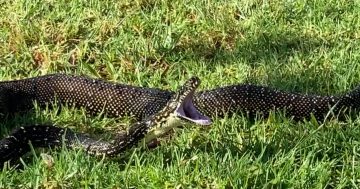
Eastern Brown Snakes engage in a male ritual conflict on Barry Drive. Photo: Supplied.
We live in the bush capital, so we shouldn’t be surprised when the bush comes to us. Such an occasion is likely to be a real shock though when our path – which may be a bike path, or footpath or even occasionally a garden path – crosses that of a snake going about its business.
Even though we know there’s no danger if we don’t do anything stupid, our heart is likely to race and our skin shivers. The stories and legends about snakes go back a long way, and make perfect sense since some snakes can be dangerous if not treated with respect.
I find it reassuring to realise that we peacefully share the suburbs – at least around the fringes and nature reserves – with a common snake which also happens to possess the second-most toxic venom of any snake in the world.
This doesn’t mean however that the Eastern Brown Snake is the second-most dangerous snake in the world, as is often claimed.
The only meaningful measure of that is how many people are actually killed by a given snake species, which is a complex combination of size, length of fangs, propensity to both bite and deliver venom (not the same thing at all) and whether it actually lives near people.
The Australian Inland Taipan is generally agreed to possess the most toxic snake venom in the world, but it lives where people very rarely encounter it.
Australian snakes, despite a concocted fearsome reputation, rank very low in ‘danger’; the average number of deaths in Australia is consistently around two a year, and some of those are due to a snake being attacked or handled.
Horses, cattle and dogs are responsible for far more deaths per year (through falls, car accidents and actual attacks). Bees kill more people than snakes, and you’re more likely to die from lightning strike than a snake strike.
A snake really doesn’t want to bite you. Venom is for hunting, not fighting and we’re not food for a snake. Venom is biologically expensive to produce and not to be wasted, while fangs are fragile and if they break the snake will probably starve to death.
A friend was recently bitten by an Eastern Brown on a Canberra bike track when he suddenly came across it and it lashed out in fright. An anxious wait in hospital ended when it was determined that the snake had refrained from ‘evenomating’.
This is typical of Brown Snakes. They are nervous and high-strung and one will thrash about in an effort to make you back off if it feels threatened. Give it space and it will slide quickly away.

A Red-bellied Black Snake eating a skink. Photo: Supplied.
In contrast, the other common local snake, the Red-bellied Black Snake, which is usually found around waterways, is slow and relaxed, interested pretty much only in frogs and small lizards.
I’ve had one slide across my feet without apparently noticing my presence. It’s almost impossible to get bitten by one, and there are no recorded human deaths by them.
Some years ago on the side of Barry Drive by Black Mountain we came across two big Eastern Browns entwined and writhing. It would be easy to interpret this as mating, but mating is a quite different matter; there is a huge size disparity between mature male and females in most local species, and the actual event is quite fleeting.
The snakes we saw were two big males wrestling for mating rights in the immediate area. It’s purely a duel of strength, fangs and venom play no part in these contests either.
On this occasion they had to defer a result, as we felt obliged to usher them off the road and into the bush for their own safety. If the wrestle had continued, one would eventually have gracefully accepted defeat and slipped away.
Living with snakes is mostly easy, as we prove every summer. Stay away from long grass and situations where you might surprise one. If one comes into your yard, which happens occasionally, it will generally move right on; if you’re concerned about it there are people who will help. Just do an on-line search for Canberra snake catchers or removals or rescue.
Most Canberrans are sensible about living with wildlife, even if they’re not always entirely comfortable with it, and I think that’s something to be proud of.



















